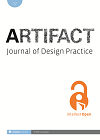-
oa Strategic design research: Co-designing organizational transformation from within
- Source: Artifact, Volume 8, Issue 1-2, Dec 2021, p. 18.1 - 18.19
-
- 08 Aug 2021
- 04 Feb 2022
- 01 Dec 2021
Abstract
In this article, we discuss and argue for the value of working with strategic design in organizational settings through inventive research practices rooted in co-design and design anthropology. More specifically, we propose a process of collaborative experimentation staged as a series of events that establish relations between everyday organizational perspectives and practices and organizational strategic documents. We base our analytical discussions and reflections on a research project carried out in the organizational setting of a labour union. We describe how a programme–experiment informed design research approach, driven by and reliant on collaborative explorations, provides a scaffold for unlocking organizational strategic management visions and goals in interaction with transformational perspectives on organizational practices. We frame our approach as a research strategy of working ‘from within’ the organizational setting, which focuses on staging dialogues between the experimental and the managerial. Such a disposition, we argue, offers important alternatives to management literatures’ current approaches to strategic design research.
Funding
- Royal Danish Academy



